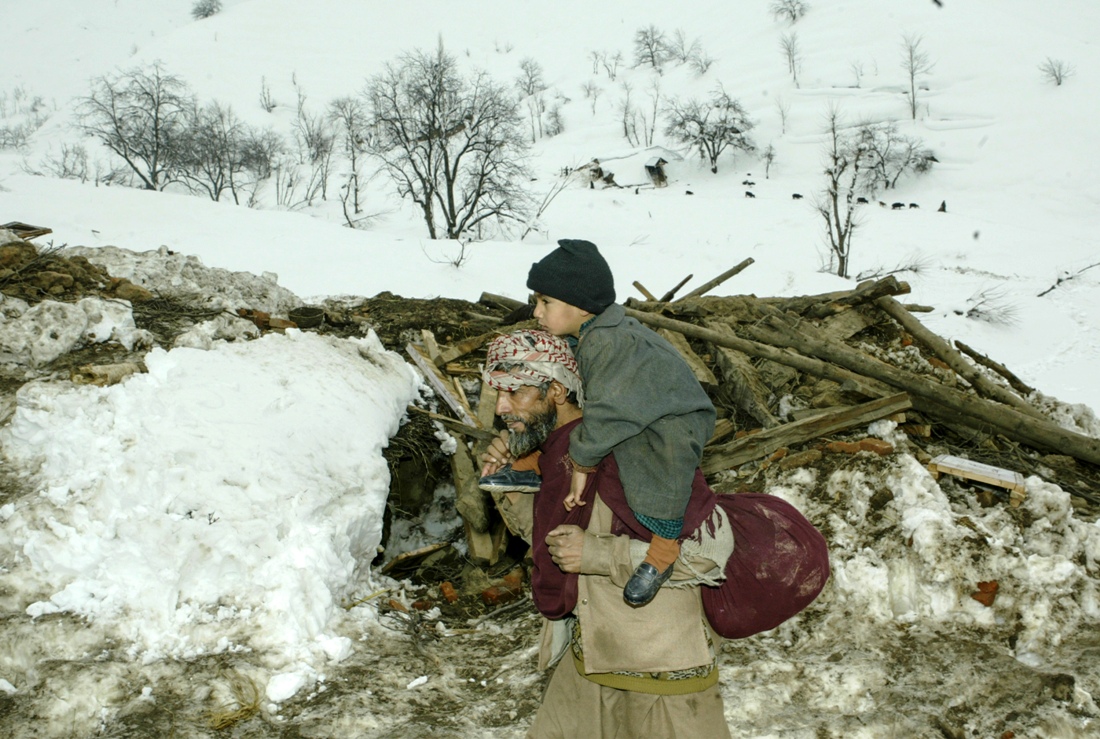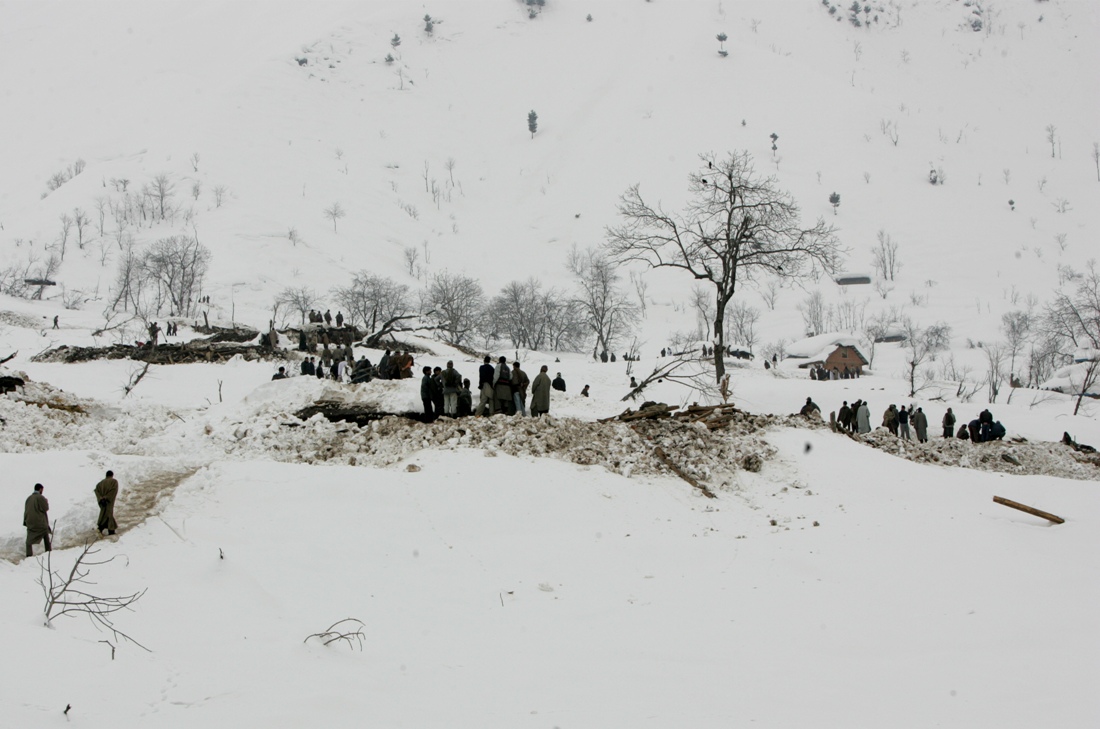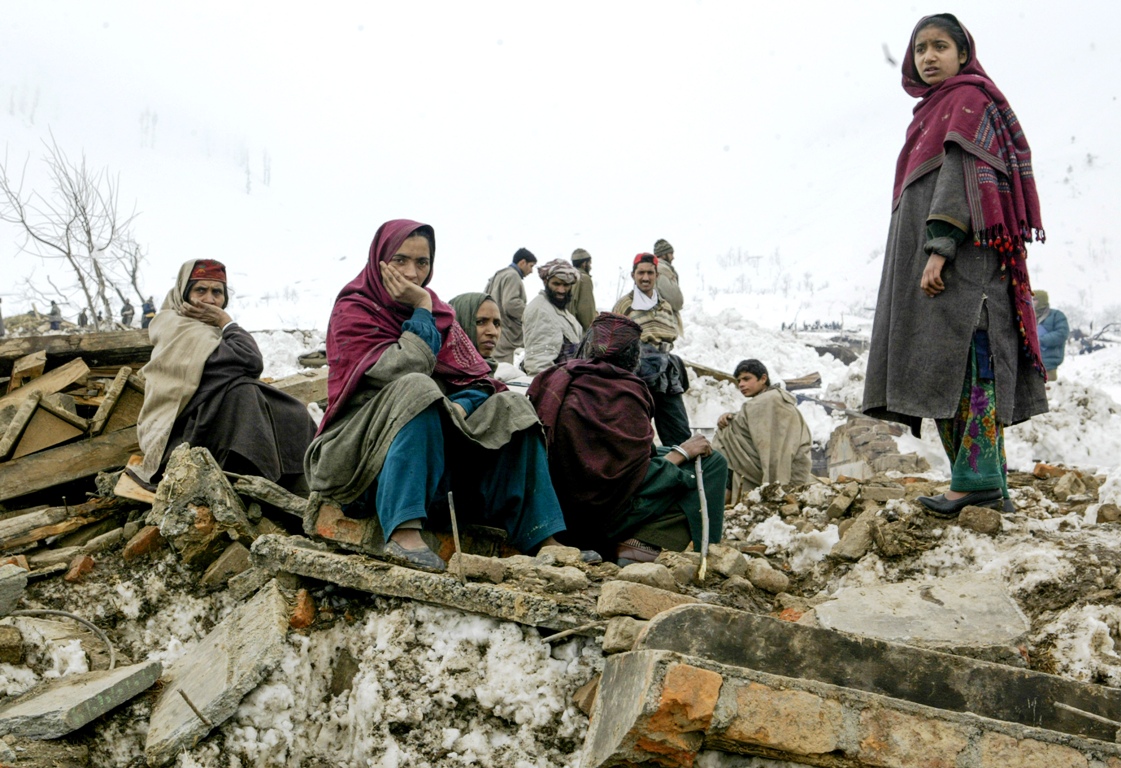Waltengu Nar, a Gujjar village down south completed 17 years of its destruction by a snowstorm on February 19. Almost two-thirds of the village population comprising more than 180 residents were killed, buried under a mountain of snow along with their dwellings. Survivors were promised rehabilitation and 17 years later 76 were living in their new homes and 44 were still waiting for their apartment to be ready. Masood Hussain located his notebook to redraft the firsthand account of the happenings and Fayaz Kabli, traced his photographs of the day, in the village on February 23, 2005, the day Srinagar reporters succeeded in reaching the village

Four days after two snowstorms flattened the picturesque Gujjar village of Waltengu Nar, a new process has started. The hutments that once housed the poor herdsmen are now making room to accommodate the mass graves.
Burials are altogether different. Frozen corpses are being taken out from the local mosque one by one, draped in white shrouds and lowered into huge graves after brief prayers. Nobody weeps, nobody cries because there is nobody to mourn.
Up above the slopes lived Master Bashir Ahmad, perhaps the most respected resident with two houses. One of his hutments was being levelled by volunteers who came from far away villages to accommodate a huge grave for ten of the 22 members of the Master’s clan.
A Rocket Train
“It was not an avalanche but a fierce snowstorm that came with the speed of a rocket and noise of a train and blew up whatever came its way”, Master said. “I watched the storm coming at 1 am in Chichipora area and then again an hour later. It darkened everything well before it hit my neighbour’s home and I jumped into a hut. Half an hour later, I heard cries of my son Talib half a kilometre away, the only survivor of my 9-member family at that time.”

Later another of his sons was rescued only to die in the neighbouring hospital for want of medicine. Hajra, his wife was recovered alive after three days by the villagers. She was literally sleeping with her dead children for all these days and has been evacuated to a neighbouring hospital.
The post where Master lived with his children is literally the main centre wherefrom almost every state agency operates. On Day 4, there are 22 cops and another party is on the way that will make them be 35.
Misplaced Priorities
The huge blanket of snow that buried this Gujjar village on Saturday would not melt before summer. But an hour-long crawl to the slopes flattened by the snowstorm explodes the propaganda blitzkrieg with which the government is trying to manage the crisis, at least by issuing statements.

The government has misplaced priorities. They sent convoys carrying rice, blankets, medicines, utensils, flour that literally jammed the yet-to-be-fully operational 15-km access road from the highway township of Qazigund. What thousands of civilians busy in digging and relief operations need is spades and shovels, and water to quench the thirst and some refreshment.
In the 116-household village with a population of over six hundred souls, 152 corpses – mostly frozen and fractured – have been recovered. Of the bodies recovered and assembled in the local mosque, 37 were buried quietly.
“Nobody is providing us with the shovels and other things. We barely are able to open and clear four hutments a day”, said Khurshid Ahmad from a neighbouring village. “With this process, it will take more than six months to clear the area”. The area is now stinking with a foul smell as more than 1000 cattle heads are reported dead under the hutments.

Khurshid’s colleague, Nazir Ahmad busy digging a mass grave said why can not the government send a battalion to help us lay the dead into the graves. He said the neighbouring villagers rescued more than 150 Waltengu Nar residents on Sunday of five died after many hours for want of treatment. “We have 30 employees in the local Primary Health Centre but nobody was there”, added Nazir.
Even a middle rung revenue officer was annoyed by the government response. “To be honest we were expecting the senior officers to visit the village today but thanks to the two great ladies who added to the crisis,” he regretted. “While Mrs Sonia Gandhi’s expected visit to Anantnag kept the entire administration on tenterhooks and prevented them to come here, Ms Mehbooba Mufti’s huge cavalcade blocked the 15-Kms access road for over three-and-a-half hours”.
While Mrs Gandhi did the aerial survey, Ms Mufti visited the village where the rescued are being housed temporarily.
Volunteers Everywhere
“We are not being permitted to move ahead”, said Abdur Rehman of Panzeth, one of the 50-odd villagers waiting for a police go-ahead in Qazigund. Carrying shovels and other petty household tools, they were stopped by the police after Omar Abdullah’s cavalcade got into the 15-Kms zigzag road that passes through huge walls of snow. “The village needs workers and not politicians who meet survivors, hurl sympathies, make promises and return”. Near the crowd are some relief-laden trucks, also stopped for the time being.
Barring the corpse count, nothing has actually altered. Gulam Nabi, a 13-year-old orphaned in the first-weekend storm is toiling hard to clear the snow from the heap of dried grass. “The storm blew him up. I saw it. But our cattle are safe. They need grass”, he said. Gulam Hussain, whose daughter Sona died of cardiac arrest is busy repairing his hut. “I need to live till we decide where to go”, he said.

But nobody is living in the village after sunset. Gulam Qadir Cheche says the place is haunted. “Two bears were noticed roaming here on Tuesday evening. Everybody is scared”, he said. While volunteers go home, the survivors spend the night in Waltengu, an hour-long trek through Halen hamlet down the slopes, the base camp for relief activities.
Iqbal Lone, a volunteer trekking a distance of 10 kilometres daily to help retrieve the corpses said their immediate concern is to trace the huts that have not been approached so far. Volunteers usually go by the survivors who locate the spots and then excavations start. Village elders said they presume over 50 residents are still missing. “People die of hypothermia if they are trapped in snow but they can survive for many days if they are stuck up in a house shrouded by frozen snow”, said one of the many doctors posted after the twin weekend storms to the hamlet.
17 Years Later
The government had initiated the process of funding the housing of 132 affected families at Wasiq Nag and Nawbug. “Initially, 128 families were listed but a survey later changed it to 120,” Deputy Commissioner Kulgam, Dr Bilal Mohiuddin said. “The work started in 2014 and in phase one 76 families were given their new homes. In phase two 44 homes were to be constructed but the availability of land was the issue and then it took its own time to get vertical housing units approved in the cabinet.” The 4-blocks being constructed at a cost of Rs 2.21 crore will be given to the families by the 2022 year-end.














